Perception of english listeners on Vietnamese vowels contrasting in rounding
This study investigated into how English listeners from Midland U.S. perceived Vietnamese
back vowels contrasting in rounding. The words were produced by Northern and Central Vietnamese
speakers. The results showed that Vietnamese vowels [o] and [u] was assimilated to English [oʊ] (77%)
and [u] (69%) respectively. [ɤ] and [ɯ] were not assimilated to any English vowels. This suggested that
Midwest U.S. speakers tended to use vowel height to map between native vs. non-native vowels while
Southern U.S. speakers in the only previous study (Shport, 2019) tended to use vowel rounding. Dialect
effects were found for Northern Vietnamese [ɯ] was assimilated to [u] (61%) while Central Vietnamese
[ɯ] was perceived the most as [ʊ] (39%). Thus, the perception of non-native sounds can be affected by
the dialects of both speakers and listeners. The study suggests that English teachers should be aware of
this issue to accommodate appropriate teaching strategies in classroom.
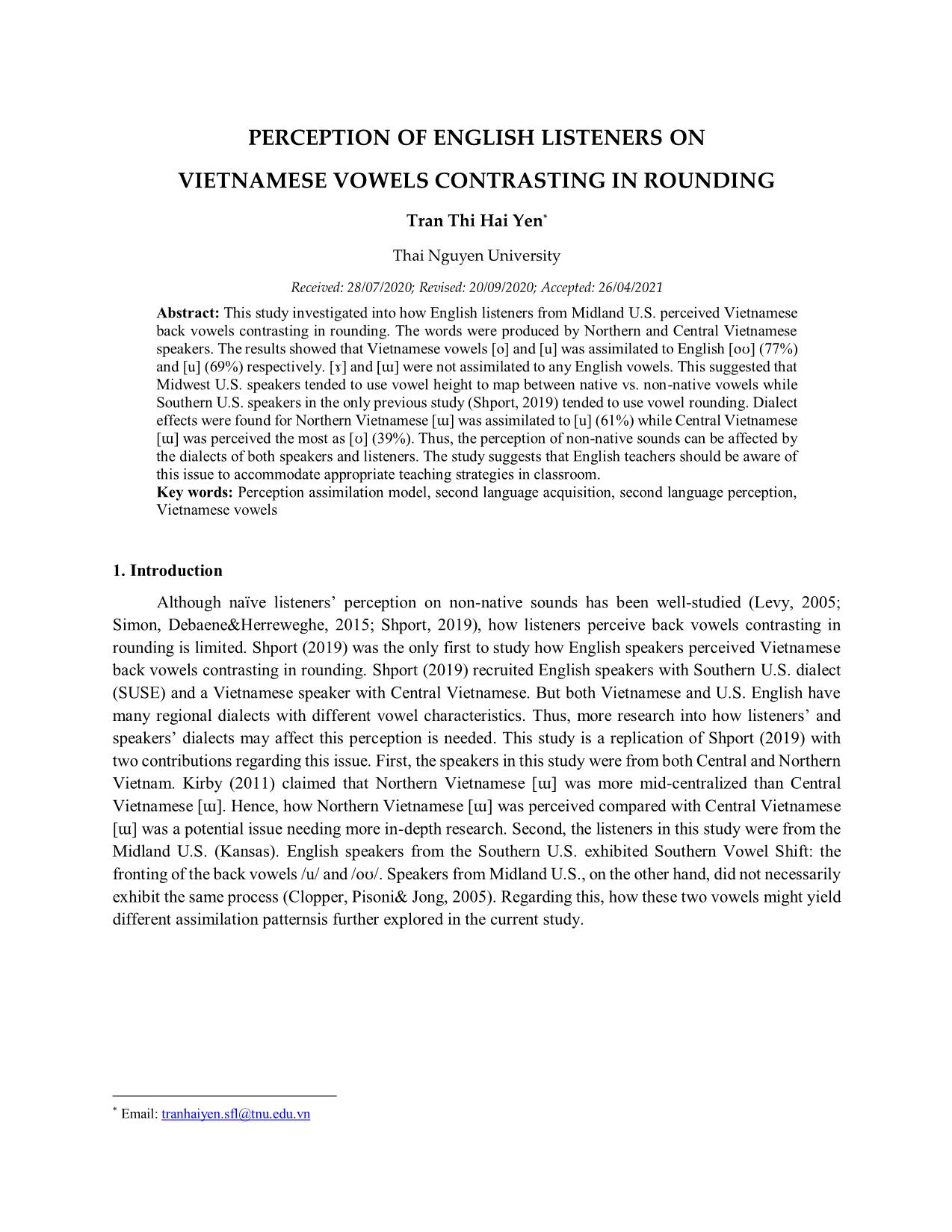
Trang 1
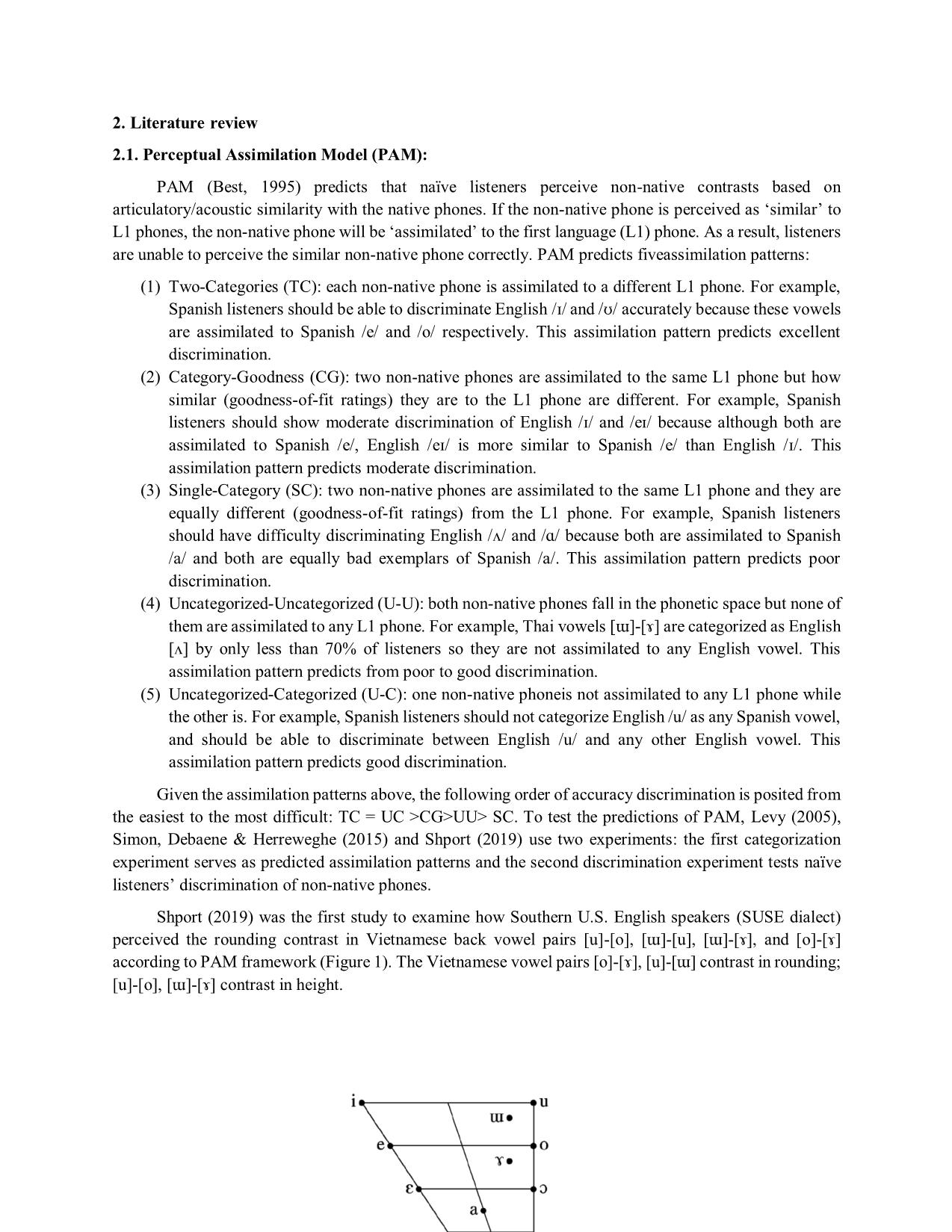
Trang 2
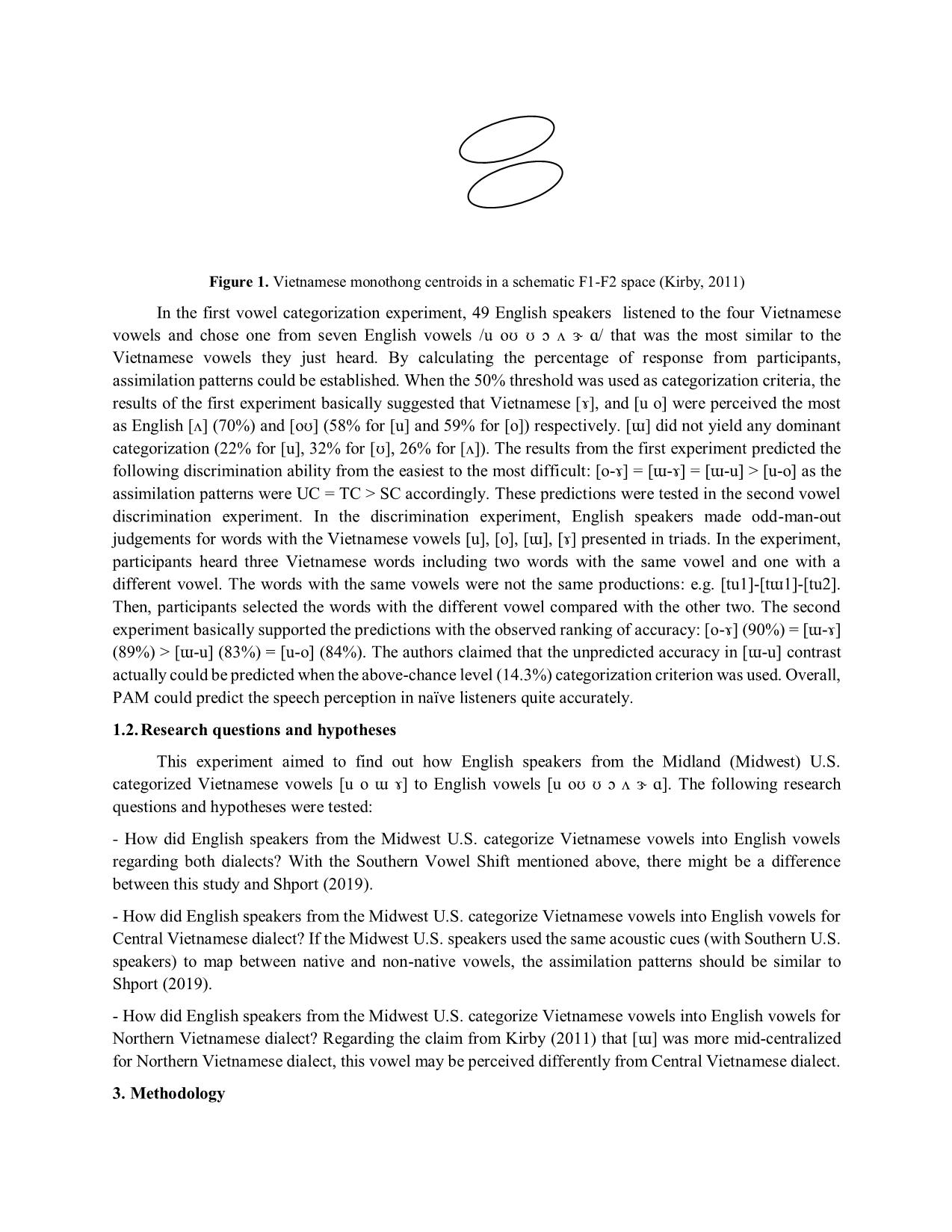
Trang 3
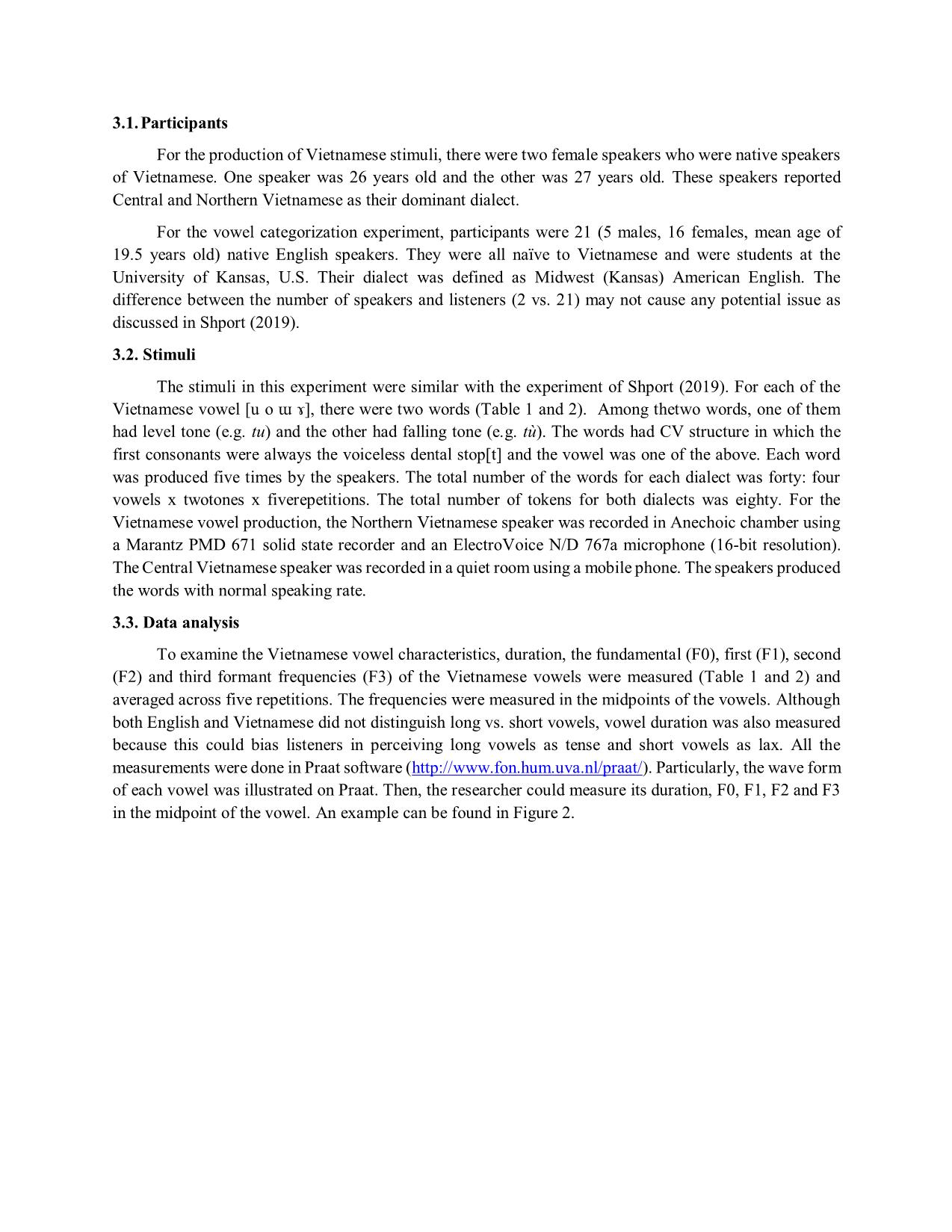
Trang 4

Trang 5

Trang 6

Trang 7
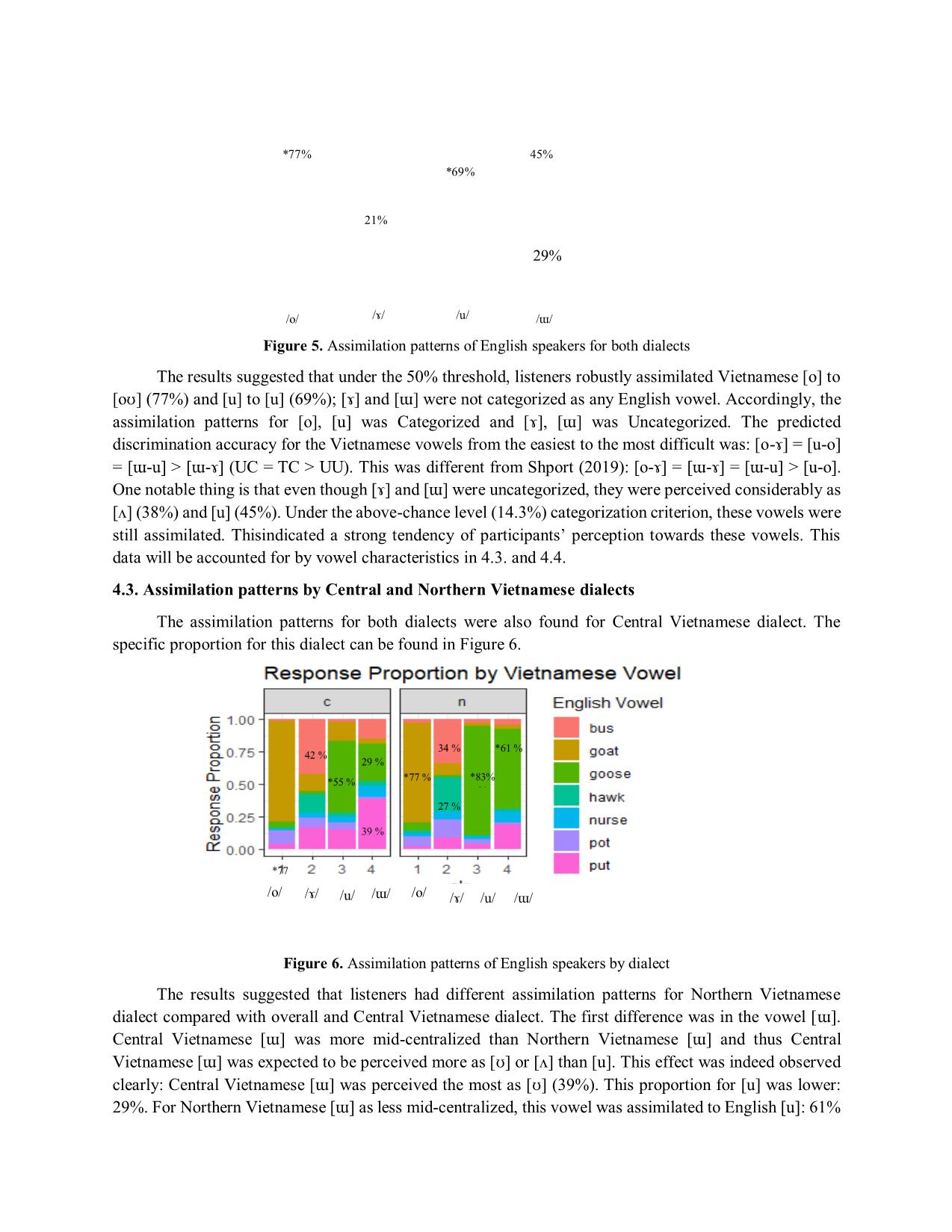
Trang 8
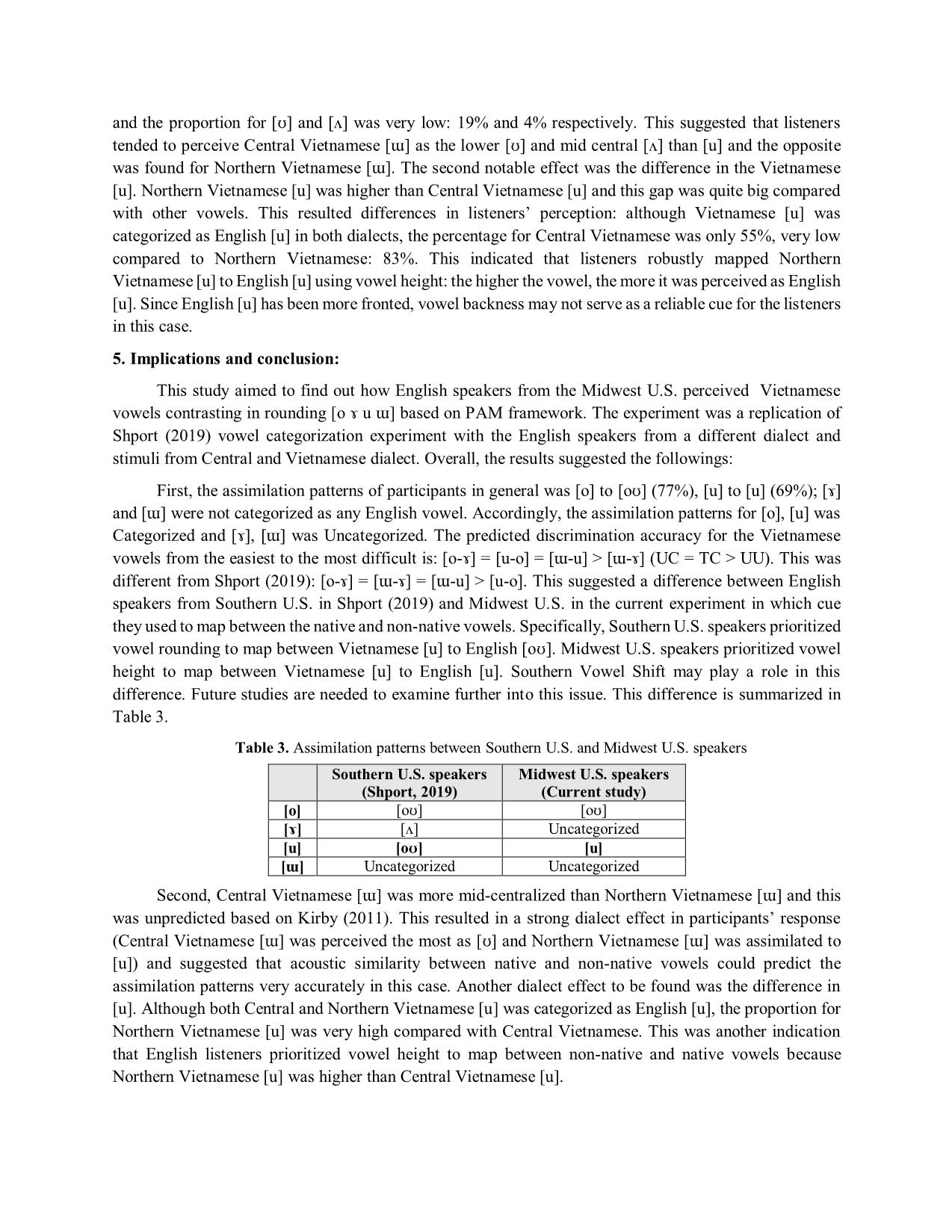
Trang 9
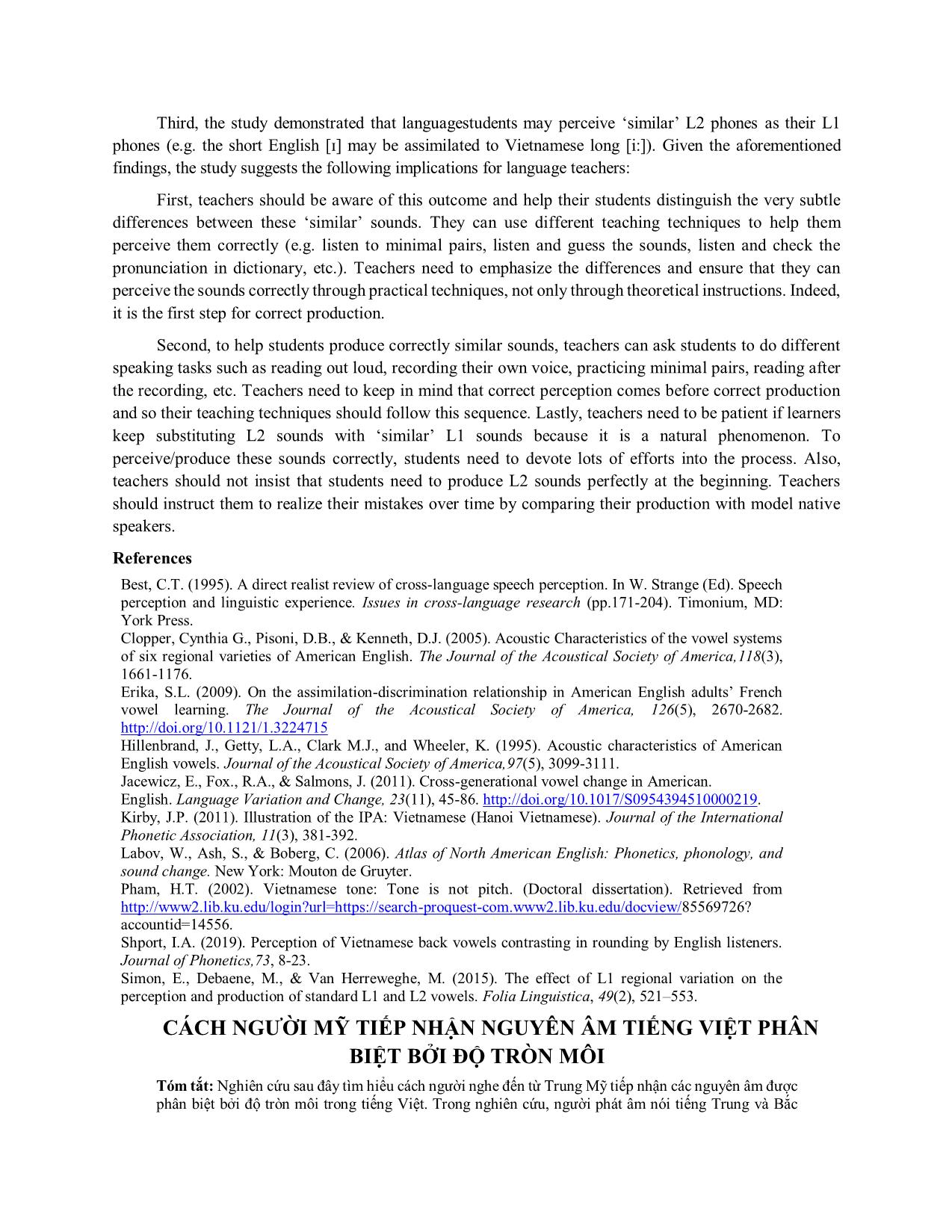
Trang 10
Tải về để xem bản đầy đủ
Tóm tắt nội dung tài liệu: Perception of english listeners on Vietnamese vowels contrasting in rounding
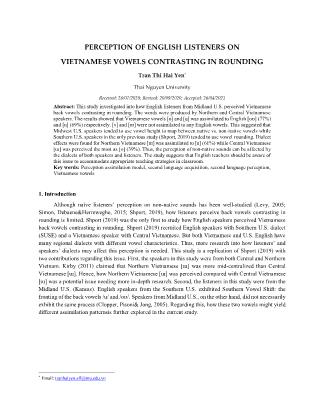
PERCEPTION OF ENGLISH LISTENERS ON VIETNAMESE VOWELS CONTRASTING IN ROUNDING Tran Thi Hai Yen* Thai Nguyen University Received: 28/07/2020; Revised: 20/09/2020; Accepted: 26/04/2021 Abstract: This study investigated into how English listeners from Midland U.S. perceived Vietnamese back vowels contrasting in rounding. The words were produced by Northern and Central Vietnamese speakers. The results showed that Vietnamese vowels [o] and [u] was assimilated to English [oʊ] (77%) and [u] (69%) respectively. [ɤ] and [ɯ] were not assimilated to any English vowels. This suggested that Midwest U.S. speakers tended to use vowel height to map between native vs. non-native vowels while Southern U.S. speakers in the only previous study (Shport, 2019) tended to use vowel rounding. Dialect effects were found for Northern Vietnamese [ɯ] was assimilated to [u] (61%) while Central Vietnamese [ɯ] was perceived the most as [ʊ] (39%). Thus, the perception of non-native sounds can be affected by the dialects of both speakers and listeners. The study suggests that English teachers should be aware of this issue to accommodate appropriate teaching strategies in classroom. Key words: Perception assimilation model, second language acquisition, second language perception, Vietnamese vowels 1. Introduction Although naïve listeners’ perception on non-native sounds has been well-studied (Levy, 2005; Simon, Debaene&Herreweghe, 2015; Shport, 2019), how listeners perceive back vowels contrasting in rounding is limited. Shport (2019) was the only first to study how English speakers perceived Vietnamese back vowels contrasting in rounding. Shport (2019) recruited English speakers with Southern U.S. dialect (SUSE) and a Vietnamese speaker with Central Vietnamese. But both Vietnamese and U.S. English have many regional dialects with different vowel characteristics. Thus, more research into how listeners’ and speakers’ dialects may affect this perception is needed. This study is a replication of Shport (2019) with two contributions regarding this issue. First, the speakers in this study were from both Central and Northern Vietnam. Kirby (2011) claimed that Northern Vietnamese [ɯ] was more mid-centralized than Central Vietnamese [ɯ]. Hence, how Northern Vietnamese [ɯ] was perceived compared with Central Vietnamese [ɯ] was a potential issue needing more in-depth research. Second, the listeners in this study were from the Midland U.S. (Kansas). English speakers from the Southern U.S. exhibited Southern Vowel Shift: the fronting of the back vowels /u/ and /oʊ/. Speakers from Midland U.S., on the other hand, did not necessarily exhibit the same process (Clopper, Pisoni& Jong, 2005). Regarding this, how these two vowels might yield different assimilation patternsis further explored in the current study. * Email: tranhaiyen.sfl@tnu.edu.vn 2. Literature review 2.1. Perceptual Assimilation Model (PAM): PAM (Best, 1995) predicts that naïve listeners perceive non-native contrasts based on articulatory/acoustic similarity with the native phones. If the non-native phone is perceived as ‘similar’ to L1 phones, the non-native phone will be ‘assimilated’ to the first language (L1) phone. As a result, listeners are unable to perceive the similar non-native phone correctly. PAM predicts fiveassimilation patterns: (1) Two-Categories (TC): each non-native phone is assimilated to a different L1 phone. For example, Spanish listeners should be able to discriminate English /ɪ/ and /ʊ/ accurately because these vowels are assimilated to Spanish /e/ and /o/ respectively. This assimilation pattern predicts excellent discrimination. (2) Category-Goodness (CG): two non-native phones are assimilated to the same L1 phone but how similar (goodness-of-fit ratings) they are to the L1 phone are different. For example, Spanish listeners should show moderate discrimination of English /ɪ/ and /eɪ/ because although both are assimilated to Spanish /e/, English /eɪ/ is more similar to Spanish /e/ than English /ɪ/. This assimilation pattern predicts moderate discrimination. (3) Single-Category (SC): two non-native phones are assimilated to the same L1 phone and they are equally different (goodness-of-fit ratings) from the L1 phone. For example, Spanish listeners should have difficulty discriminating English /ʌ/ and /ɑ/ because both are assimilated to Spanish /a/ and both are equally bad exemplars of Spanish /a/. This assimilation pattern predicts poor discrimination. (4) Uncategorized-Uncategorized (U-U): both non-native phones fall in the phonetic space but none of them are assimilated to any L1 phone. For example, Thai vowels [ɯ]-[ɤ] are categorized as English [ʌ] by only less than 70% of listeners so they are not assimilated to any English vowel. This assimilation pattern predicts from poor to good discrimination. (5) Uncategorized-Categorized (U-C): one non-native phoneis not assimilated to any L1 phone while the other is. For example, Spanish listeners should not categorize English /u/ as any Spanish vowel, and should be able to discriminate between English /u/ and any other English vowel. This assimilation pattern predicts good discrimination. Given the assimilation patterns above, the following order of accuracy discrimination is posited from the easiest to the most difficult: TC = UC >CG>UU> SC. To test the predictions of PAM, Levy (2005), Simon, Debaene & Herreweghe (2015) and Shport (2019) use two experiments: the first categorization experiment serves as predicted assimilation patterns and the second discrimination experiment tests naïve listeners’ discrimination of non-native phones. Shport (2019) was the first study to examine how Southern U.S. English speakers (SUSE dialect) perceived the rounding contrast in Vietnamese back vowel pairs [u]-[o], [ɯ]-[u], [ɯ]-[ɤ], and [o]-[ɤ] according to PAM framework (Figure ... ntral speaker (456ms for words with falling tone and 334ms for words with level tone) compared with the Northern speaker (445ms for words with falling tone and 406ms for words with level tone). The mean durations of the words were shaded in the tables. This suggested that participants may perceive the vowels with falling tone as English tense vowels and the vowels with level tone as English lax vowels. Tone effect was not discussed in this paper because of its limited scope. Second, mean F1, F2, F3 in the vowels produced by the Central speaker most of the time were higher than these in the vowels produced by the Northern speaker. The plotting of F1-F2 in Figure 2 suggested that the difference in F1 and F2 in the production of two dialects was not very remarkable with the exception of [ɯ]. Central Vietnamese [ɯ] had the biggest difference in F1(82Hz) and F2(303Hz) compared with Northern Vietnamese [ɯ]. Table 1. Vowel characteristics in eight Vietnamese words produced by Central Vietnamese speaker Vowel Word Tone F0 (Hz) Duration (ms) F1 (Hz) F2 (Hz) F3 (Hz) [u] Tu ‘knock up’ Level 293 289 367 909 3601 Tù ‘prison’ Falling 218 444 459 975 3399 Mean 255 366 413 942 3500 [ɯ] Tư ‘four’ Level 296 322 406 1740 3682 từ ‘word’ Falling 220 470 491 1705 3258 Mean 258 396 449 1723 3470 [o] Tô ‘bowl’ Level 275 331 633 929 3545 tồ non word Falling 226 436 453 946 3224 Mean 251 384 543 938 3384 [ɤ] Tơ ‘silk’ Level 276 396 639 1271 3470 tờ ‘sheet’ Falling 218 483 527 1345 3235 Mean 247 439 583 1308 3353 Table 2. Vowel characteristics in eight Vietnamese vowels produced by Northern Vietnamese speaker Vowel Word Tone F0 (Hz) Duration (ms) F1 (Hz) F2 (Hz) F3 (Hz) [u] Tu ‘knock up’ Level 297 400 342 916 3041 Tù ‘prison’ Falling 219 476 348 839 2698 Mean 258 438 345 877 2870 [ɯ] Tư ‘four’ Level 297 414 348 1472 3060 từ ‘word’ Falling 223 455 387 1368 2892 Mean 260 435 367 1420 2976 [o] Tô ‘bowl’ Level 300 408 582 992 3054 tồ non word Falling 214 458 393 884 2879 Mean 257 408 488 938 2967 [ɤ] Tơ ‘silk’ Level 290 413 567 1400 3254 Tờ ‘sheet’ Falling 207 452 555 1310 3176 Mean 249 432 561 1355 3215 The mean F1 and F2 of Vietnamese Northern and Central vowels are plotted in Figure 3. The vowels [u], [ɤ] and [o] produced by two speakers were quite similar in the vowel space. The vowel that was the most different from the two speakers was [ɯ]. However, this vowel was different in an unexpected way: Kirby (2011) claimed that Northern [ɯ] was mid-centralized. Yet in this study, the Central speaker produced more mid-centralized [ɯ] than the Northern speaker. Shport (2019) found that Central Vietnamese [ɯ] was partly assimilated to English [ʊ] (32%), [ʌ] (26%) and [u] (22%). Thus, if acoustic similarity between the native vs. non-native vowels could predict the assimilation patterns as PAM claims, Central Vietnamese [ɯ] in this study may be perceived more as English lower [ʊ] or mid central [ʌ] than high back [u] because it was more mid-centralized. Figure 3. Mean F1 and F2 values of Northern and Central Vietnamese speakers 4.2. Assimilation patterns elicited by the speakers in both dialects A comparison between Vietnamese and English vowels can be found in Figure 4 below. English vowel characteristics were from Hillenbrand, Getty, Clark, and Wheeler (1995).The vowels within the same circles were close in the vowel space. Figure 4. Mean F1 and F2 values of English and Vietnamese vowels Figure 5 shows the assimilation patterns of the listeners for both Vietnamese dialects. 38% Figure 5. Assimilation patterns of English speakers for both dialects The results suggested that under the 50% threshold, listeners robustly assimilated Vietnamese [o] to [oʊ] (77%) and [u] to [u] (69%); [ɤ] and [ɯ] were not categorized as any English vowel. Accordingly, the assimilation patterns for [o], [u] was Categorized and [ɤ], [ɯ] was Uncategorized. The predicted discrimination accuracy for the Vietnamese vowels from the easiest to the most difficult was: [o-ɤ] = [u-o] = [ɯ-u] > [ɯ-ɤ] (UC = TC > UU). This was different from Shport (2019): [o-ɤ] = [ɯ-ɤ] = [ɯ-u] > [u-o]. One notable thing is that even though [ɤ] and [ɯ] were uncategorized, they were perceived considerably as [ʌ] (38%) and [u] (45%). Under the above-chance level (14.3%) categorization criterion, these vowels were still assimilated. Thisindicated a strong tendency of participants’ perception towards these vowels. This data will be accounted for by vowel characteristics in 4.3. and 4.4. 4.3. Assimilation patterns by Central and Northern Vietnamese dialects The assimilation patterns for both dialects were also found for Central Vietnamese dialect. The specific proportion for this dialect can be found in Figure 6. Figure 6. Assimilation patterns of English speakers by dialect The results suggested that listeners had different assimilation patterns for Northern Vietnamese dialect compared with overall and Central Vietnamese dialect. The first difference was in the vowel [ɯ]. Central Vietnamese [ɯ] was more mid-centralized than Northern Vietnamese [ɯ] and thus Central Vietnamese [ɯ] was expected to be perceived more as [ʊ] or [ʌ] than [u]. This effect was indeed observed clearly: Central Vietnamese [ɯ] was perceived the most as [ʊ] (39%). This proportion for [u] was lower: 29%. For Northern Vietnamese [ɯ] as less mid-centralized, this vowel was assimilated to English [u]: 61% *77% 21% *69% 45% 29% /o/ /ɤ/ /u/ /ɯ/ *77 % 42 % *55 % 29 % 39 % *77 % 34 % 27 % *83% % *61 % /o/ /o/ /ɤ/ /ɤ/ /u/ /u/ /ɯ/ /ɯ/ and the proportion for [ʊ] and [ʌ] was very low: 19% and 4% respectively. This suggested that listeners tended to perceive Central Vietnamese [ɯ] as the lower [ʊ] and mid central [ʌ] than [u] and the opposite was found for Northern Vietnamese [ɯ]. The second notable effect was the difference in the Vietnamese [u]. Northern Vietnamese [u] was higher than Central Vietnamese [u] and this gap was quite big compared with other vowels. This resulted differences in listeners’ perception: although Vietnamese [u] was categorized as English [u] in both dialects, the percentage for Central Vietnamese was only 55%, very low compared to Northern Vietnamese: 83%. This indicated that listeners robustly mapped Northern Vietnamese [u] to English [u] using vowel height: the higher the vowel, the more it was perceived as English [u]. Since English [u] has been more fronted, vowel backness may not serve as a reliable cue for the listeners in this case. 5. Implications and conclusion: This study aimed to find out how English speakers from the Midwest U.S. perceived Vietnamese vowels contrasting in rounding [o ɤ u ɯ] based on PAM framework. The experiment was a replication of Shport (2019) vowel categorization experiment with the English speakers from a different dialect and stimuli from Central and Vietnamese dialect. Overall, the results suggested the followings: First, the assimilation patterns of participants in general was [o] to [oʊ] (77%), [u] to [u] (69%); [ɤ] and [ɯ] were not categorized as any English vowel. Accordingly, the assimilation patterns for [o], [u] was Categorized and [ɤ], [ɯ] was Uncategorized. The predicted discrimination accuracy for the Vietnamese vowels from the easiest to the most difficult is: [o-ɤ] = [u-o] = [ɯ-u] > [ɯ-ɤ] (UC = TC > UU). This was different from Shport (2019): [o-ɤ] = [ɯ-ɤ] = [ɯ-u] > [u-o]. This suggested a difference between English speakers from Southern U.S. in Shport (2019) and Midwest U.S. in the current experiment in which cue they used to map between the native and non-native vowels. Specifically, Southern U.S. speakers prioritized vowel rounding to map between Vietnamese [u] to English [oʊ]. Midwest U.S. speakers prioritized vowel height to map between Vietnamese [u] to English [u]. Southern Vowel Shift may play a role in this difference. Future studies are needed to examine further into this issue. This difference is summarized in Table 3. Table 3. Assimilation patterns between Southern U.S. and Midwest U.S. speakers Southern U.S. speakers (Shport, 2019) Midwest U.S. speakers (Current study) [o] [oʊ] [oʊ] [ɤ] [ʌ] Uncategorized [u] [oʊ] [u] [ɯ] Uncategorized Uncategorized Second, Central Vietnamese [ɯ] was more mid-centralized than Northern Vietnamese [ɯ] and this was unpredicted based on Kirby (2011). This resulted in a strong dialect effect in participants’ response (Central Vietnamese [ɯ] was perceived the most as [ʊ] and Northern Vietnamese [ɯ] was assimilated to [u]) and suggested that acoustic similarity between native and non-native vowels could predict the assimilation patterns very accurately in this case. Another dialect effect to be found was the difference in [u]. Although both Central and Northern Vietnamese [u] was categorized as English [u], the proportion for Northern Vietnamese [u] was very high compared with Central Vietnamese. This was another indication that English listeners prioritized vowel height to map between non-native and native vowels because Northern Vietnamese [u] was higher than Central Vietnamese [u]. Third, the study demonstrated that languagestudents may perceive ‘similar’ L2 phones as their L1 phones (e.g. the short English [ɪ] may be assimilated to Vietnamese long [i:]). Given the aforementioned findings, the study suggests the following implications for language teachers: First, teachers should be aware of this outcome and help their students distinguish the very subtle differences between these ‘similar’ sounds. They can use different teaching techniques to help them perceive them correctly (e.g. listen to minimal pairs, listen and guess the sounds, listen and check the pronunciation in dictionary, etc.). Teachers need to emphasize the differences and ensure that they can perceive the sounds correctly through practical techniques, not only through theoretical instructions. Indeed, it is the first step for correct production. Second, to help students produce correctly similar sounds, teachers can ask students to do different speaking tasks such as reading out loud, recording their own voice, practicing minimal pairs, reading after the recording, etc. Teachers need to keep in mind that correct perception comes before correct production and so their teaching techniques should follow this sequence. Lastly, teachers need to be patient if learners keep substituting L2 sounds with ‘similar’ L1 sounds because it is a natural phenomenon. To perceive/produce these sounds correctly, students need to devote lots of efforts into the process. Also, teachers should not insist that students need to produce L2 sounds perfectly at the beginning. Teachers should instruct them to realize their mistakes over time by comparing their production with model native speakers. References Best, C.T. (1995). A direct realist review of cross-language speech perception. In W. Strange (Ed). Speech perception and linguistic experience. Issues in cross-language research (pp.171-204). Timonium, MD: York Press. Clopper, Cynthia G., Pisoni, D.B., & Kenneth, D.J. (2005). Acoustic Characteristics of the vowel systems of six regional varieties of American English. The Journal of the Acoustical Society of America,118(3), 1661-1176. Erika, S.L. (2009). On the assimilation-discrimination relationship in American English adults’ French vowel learning. The Journal of the Acoustical Society of America, 126(5), 2670-2682. Hillenbrand, J., Getty, L.A., Clark M.J., and Wheeler, K. (1995). Acoustic characteristics of American English vowels. Journal of the Acoustical Society of America,97(5), 3099-3111. Jacewicz, E., Fox., R.A., & Salmons, J. (2011). Cross-generational vowel change in American. English. Language Variation and Change, 23(11), 45-86. Kirby, J.P. (2011). Illustration of the IPA: Vietnamese (Hanoi Vietnamese). Journal of the International Phonetic Association, 11(3), 381-392. Labov, W., Ash, S., & Boberg, C. (2006). Atlas of North American English: Phonetics, phonology, and sound change. New York: Mouton de Gruyter. Pham, H.T. (2002). Vietnamese tone: Tone is not pitch. (Doctoral dissertation). Retrieved from accountid=14556. Shport, I.A. (2019). Perception of Vietnamese back vowels contrasting in rounding by English listeners. Journal of Phonetics,73, 8-23. Simon, E., Debaene, M., & Van Herreweghe, M. (2015). The effect of L1 regional variation on the perception and production of standard L1 and L2 vowels. Folia Linguistica, 49(2), 521–553. CÁCH NGƯỜI MỸ TIẾP NHẬN NGUYÊN ÂM TIẾNG VIỆT PHÂN BIỆT BỞI ĐỘ TRÒN MÔI Tóm tắt: Nghiên cứu sau đây tìm hiểu cách người nghe đến từ Trung Mỹ tiếp nhận các nguyên âm được phân biệt bởi độ tròn môi trong tiếng Việt. Trong nghiên cứu, người phát âm nói tiếng Trung và Bắc Việt Nam. Kết quả cho thấy các âm [o] [u] tiếng Việt đã được người nghe đồng hóa với các âm [oʊ] (77%) [u] (69%). Các âm [ɤ] [ɯ] không bị đồng hóa với nguyên âm tiếng Anh nào. Kết quả gợi ý khi nghe các âm ngoại lai, người nghe từ Trung Mỹ có xu hướng dùng độ cao để so sánh với âm trong tiếng mẹ đẻ. Tuy nhiên người nghe từ Nam Mỹ trong nghiên cứu của Shport (2019) lại dùng độ tròn môi. Ảnh hưởng của phương ngữ cũng được ghi nhận khi âm [ɯ] trong tiếng Bắc được đồng hóa sang [u] (61%) nhưng âm [ɯ] trong tiếng Nam lại được tiếp nhận nhiều nhất là [ʊ] (39%). Vì vậy, sự tiếp nhận âm ngoại lai có thể được ảnh hưởng bởi cả phương ngữ của người nghe và người nói. Nghiên cứu cho thấy giáo viên tiếng Anh nên nhận thức được điều này để có thể dùng những chiến lược thích hợp cho lớp học. Từkhóa: Mô hình tiếp nhận đồng hóa, đắc thụ ngôn ngữ hai, tiếp nhận ngôn ngữ hai, nguyên âm trong tiếng Việt
File đính kèm:
 perception_of_english_listeners_on_vietnamese_vowels_contras.pdf
perception_of_english_listeners_on_vietnamese_vowels_contras.pdf

